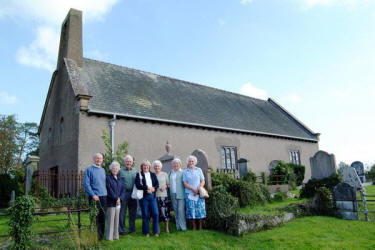
The Middle Church, Ballinderry
was open to visitors on Saturday 9th
September - European Heritage
Open Dasy
2006. Pictured at the church last Saturday morning
is L to R: The Rev Canon Ernest Harris - Rector and
Daphne Davidson (daughter of the Rev John Lowe -
Rector 1940 to 1972). Also included are visitors -
Arthur Warwick from Lisburn and Gillian Dalton, Nan
Watson, Olivia Steele and Mena Smyth from
Carrickfergus.
The Middle Church, Ballinderry was built
in 1668 at the direction of the Bishop of Down, Connor and
Dromore, Jeremy Taylor, who also financed its construction. It
was built to replace the medieval church of the parish of
Ballinderry, the ruins of which still exist two miles away at
Portmore, close to Lough Beg. He chose this site for the new
church because it was more convenient and accessible than the
old church, being in the centre of the parish and on a country
road. This is how the Middle Church got its name. It is also
often known as �Jeremy Taylor�s Church�.
In 1824 this church was itself superseded
by the construction of a new parish church close to Upper
Ballinderry village. Although the parish church continues today
as the centre of worship, the Middle Church has regular evening
services in the summer months and other services throughout the
year. The Middle Church graveyard is still the burying ground
for the parish. The oldest headstone dates from the late 17th
century.
The Middle Church fell into disrepair after
the opening of the new parish church and photographs taken in
the late 19th century show the east gable end and
part of the roof covered in ivy. In 1902 a programme of
restoration was undertaken, with the aid of a donation of �2000
from Mrs Walkington, Oatlands, Upper Ballinderry. It was
re-roofed and the windows were re-glazed. Prior to the
restoration, the exterior was white-washed like a traditional
cottage or barn, hence its description as a �barn� church. In
more recent times the parish has sought to maintain the physical
soundness of the building without altering its character. There
is no electricity so services are conducted by the aid of candle
or other portable lighting and heating.
The church measures 71 feet long by 29 feet
wide. It is thought that some of the wood used in its
construction was removed from the medieval church at Portmore
and re-used here. All of the oak would have been felled in the
great oak forests that covered this district, which was
known as Killultagh (Coil Ultagh - the great wood of
Ulster). The interior has the original 17th century
oak pews with fixed candleholders, communion table and a
three-deck oak �pepper pot� pulpit, placed at the side of the
church. The pulpit�s design means that the seat in the lowest
position can be used by the parish clerk, the middle section
used for the readings and additional prayers, and the upper
section by the preacher. The lowest seat was known as the �Amen
Corner� because the clerk led the responses by the
congregation. The large pew opposite the pulpit is
traditionally known as �Lord Conway�s pew�. Fixed to the west
wall is a former pew door, which has the date 1668 and two sets
of initials carved on it. The church possesses a silver chalice
dating from the 1660s, which is inscribed �the cup of
Ballinderry� and several 18th century Prayer Books.
There is a chest dated 1706 and four long handled brass
collection pans. A funeral hatchment bearing the arms of Bishop
Taylor is on the wall opposite the pulpit. An external
staircase gives access to the gallery, which is an eighteenth
century addition to the church, made presumably to cope with an
increasing congregation. There are two circular windows in the
west gable, over which is a simple bell turret. The original 17th
century bell was taken down in 1869, at a time when the church
was not in use. It was sold in Dublin and later recast into a
bell for Gilford Church. The present bell was donated by Wing
Commander Higginson in 1954.
Bishop Jeremy Taylor (1613-1667) was a
close friend of Edward, 1st Earl of Conway and
Killultagh, whose family owned all the land between Derriaghy
and the shores of Lough Neagh and developed the town of
Lisburn. Bishop Taylor was chaplain to Charles 1 and therefore
fell from favour during Cromwell�s time. Through the patronage
of Lord Conway, he came to Lisburn in the 1650s. He also spent
time at Conway�s house at Portmore and from this peaceful
location developed his interest in Ballinderry. Taylor was a
noted theologian who published several significant books,
including �Holy Living� and �Holy Dying�. The preface of
another, Ductor Dubitantium or the Rule of Conscience, reads
�from my study at Portmore in Killultagh, October 5, 1659�. He
died in Lisburn in August 1667 and was buried in Dromore
Cathedral.
Church historians will be interested to
know that the Moravian Church at Ballinderry, which
was
opened
on
Christmas Day 1751, was also open to visitors for
European Heritage Open Days 2006. For information on all 134
churches and places of worship in the Lisburn City Council area
go to the �Lisburn Churches� page of
www.lisburn.com.